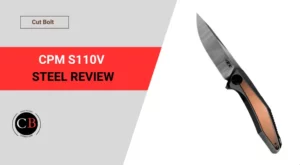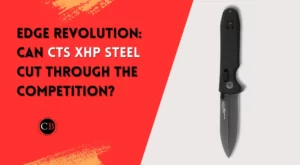With so many knives to choose from, you may come across AUS 8A steel and wonder – what makes it different? This versatile Japanese-made stainless steel is popular among knife makers and buyers alike.
The question comes to mind – is AUS 8A steel good for knives?
I’ll discuss AUS 8A’s composition, hardness, edge retention, corrosion resistance, and how it compares to similar steels. Gain key insights on the performance qualities of AUS 8A to determine if it fits your needs when choosing a new knife.
Whether you’re a knife aficionado or simply want an informed start to your search, this overview of AUS 8A knife steel will equip you with the knowledge to discern your best blade.
- What is AUS 8A steel?
- AUS 8A steel chemical composition
- How does AUS 8A differ from AUS 8?
- The hardness of AUS 8A knife steel
- Pros and Cons of AUS 8A steel
- Comparison AUS 8A and 440B/C
- Strengths and weaknesses of AUS 8A knife steel
- Is AUS 8A a stainless steel?
- Is AUS 8A steel good for knives?
- Final Words: AUS 8A steel review
What is AUS 8A steel?
AUS 8A steel is a Japanese-made stainless steel often used for knife making. It contains 0.75-0.80% low carbon and 13.5-14.5% chromium for an optimal balance of corrosion resistance, hardness, edge retention and toughness.
With typical hardness levels reaching 56-59 on the Rockwell scale after heat treatment, AUS 8A knives perform well for daily use while also taking and holding sharp edges admirably.
The enhanced levels of nickel, manganese and other alloys boost the steel’s tensile strength allowing complex grinds. Considered above average for budget blades, it matches similar steels like 440A in many regards while presenting an affordable step-up viable for most cooking and EDC needs.
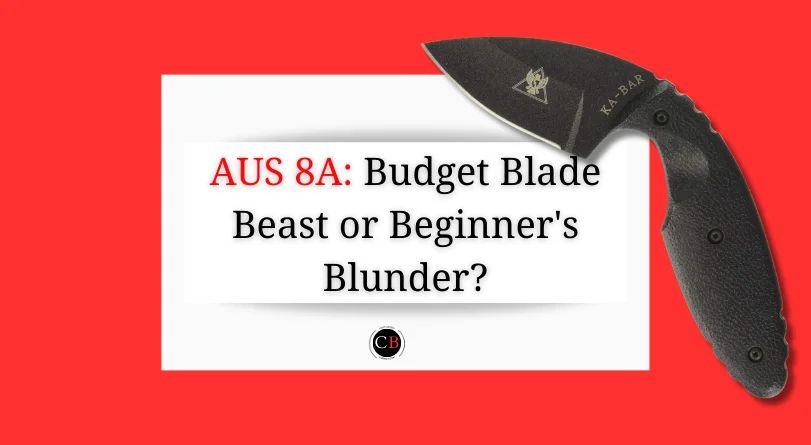
AUS 8A steel chemical composition
Here is the chemical composition of AUS-8A steel:
| Element | Weight Percentage (%) | Role in Steel |
|---|---|---|
| Carbon (C) | 0.70 – 0.75 | A primary contributor to hardness, wear resistance, and strength |
| Chromium (Cr) | 13.0 – 14.5 | Enhances corrosion resistance and stain resistance |
| Manganese (Mn) | 0.5 | Improves hardenability and toughness |
| Silicon (Si) | 1 | Deoxidizer and improves grain refinement |
| Nickel (Ni) | 0.49 | Improves toughness and corrosion resistance |
| Molybdenum (Mo) | 0.10 – 0.30 | Enhances tempering stability and hardenability |
| Vanadium (V) | 0.10 – 0.26 | Improves fine grain size and hardenability |
| Phosphorus (P) | ≤ 0.04 | Minimizes embrittlement |
| Sulfur (S) | ≤ 0.03 | Minimizes hot shortness |
| Iron (Fe) | Balance | Base metal |
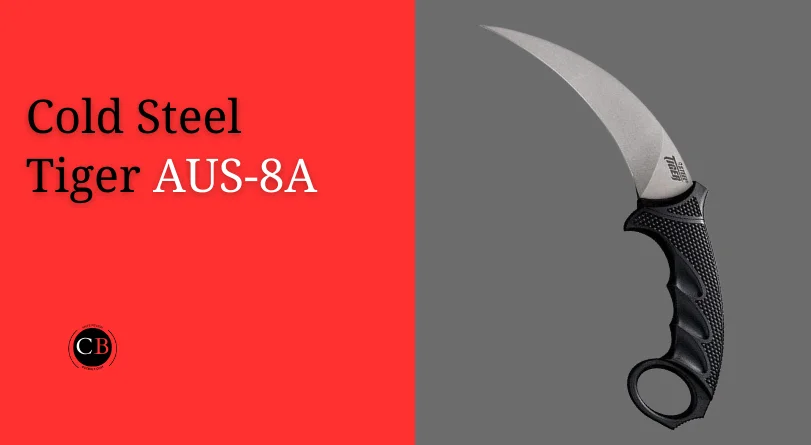
How does AUS 8A differ from AUS 8?
Often referred to as “8A steel,” AUS-8A boasts impressive rust resistance and effortless sharpening, much like its close cousin, AUS-8. The key difference lies in the heat treatment (annealing) process that AUS-8A undergoes, making it more malleable.
Despite this distinction, both steels share the same core composition of carbon and alloying elements. They offer performance comparable to the American-made 440 series, though produced primarily by a Japanese company, Aichi Steel Corporation. While some AUS steel might be manufactured in China, the AUS and 440 lines remain distinct based on their origin and specific characteristics.
In short, AUS 8A is higher quenched and tempered AUS 8 steel.
Related: How good is BG42 steel for knives?
The hardness of AUS 8A knife steel
The hardness of AUS-8A steel typically falls within the range of 57 to 61 HRC (Rockwell Hardness). This range indicates a good balance between edge retention and toughness.
While the exact hardness can vary slightly depending on the specific heat treatment and manufacturing process, it generally falls within this range. Here’s some additional information about hardness in relation to AUS-8A:
- Higher hardness (closer to 61 HRC): Improves edge retention but might make the steel more prone to chipping.
- Lower hardness (closer to 57 HRC): Makes the steel more resistant to chipping but might dull faster.
In comparison with other steels, AUS 8/AUS 8A ranks as follows:
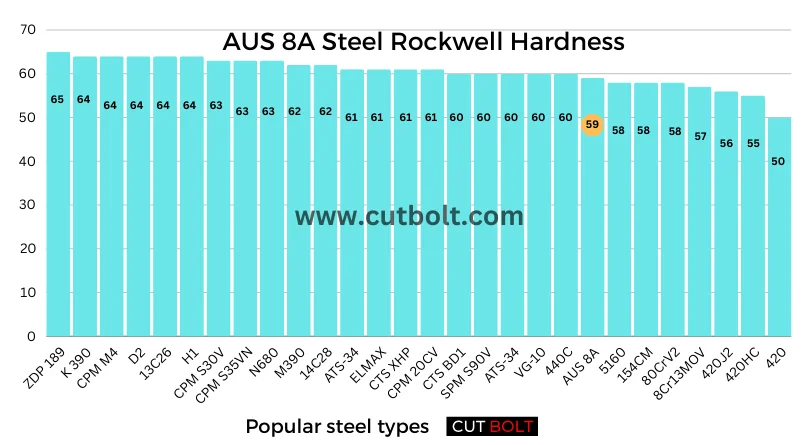
Pros and Cons of AUS 8A steel
Here are some of the key advantages of AUS 8A steel for knives:
- Good corrosion resistance: The 13.5-14.5% chromium content provides solid resistance to rust and stains. It will hold up well to everyday use and cleaning.
- Decent edge retention: The 0.75-0.80% carbon enables AUS 8A blades to be sharpened very sharp and retain that edge for reasonable periods before needing resharpening.
- Toughness and durability: Proper heat treatment gives AUS 8A favorable ductility, tensile strength and tolerance to impacts without chipping or breaking.
- Ease of sharpening: While not in the same class as powder steels, AUS 8A can be brought back to razor sharpness without too much effort on oil stones or other sharpening systems.
- Budget-friendly cost: Quality AUS 8A knives can be produced more affordably than premium steel blades, passing significant savings to the consumer.
The balance of corrosion resistance, sharpenability, toughness and value make AUS 8A steel an attractive choice for knife makers and buyers looking for capable real-world performance without breaking the bank.
Here are some potential disadvantages of AUS 8A steel to consider:
- Moderate edge retention: While AUS 8A can get very sharp, the edge lasts only moderately long before needing resharpening, especially with heavy duty use. It doesn’t hold an edge as long as higher alloy or powder steels.
- Can be brittle if hardened incorrectly: The heat treatment process for AUS 8A is important to get right. Improper hardening can leave it with subpar toughness or shock resistance.
- Limited corrosion resistance for its class: The 13-14% chromium is decent but lower than premium cutlery grades optimized for environments like marine use or highly humid areas. Requires more maintenance.
- Prone to microchipping: The thin, acute edge bevels favored for maximum sharpness mean AUS 8A edges are vulnerable to tiny chips if dropped or impacted on hard materials.
- Doesn’t take as fine an edge as better grades: While able to get moderately sharp, AUS 8A cannot achieve and retain the extreme sharpness of elite cutlery steels. Sharpness potential is limited.
Similar to: 440 series steels (American-made), offering comparable performance.
Different from: AUS-8 (which hasn’t undergone annealing) in terms of workability and potentially edge retention.
Overall:
AUS-8A is a good choice for those seeking a balance of affordability, rust resistance, ease of sharpening, and decent toughness for everyday use. However, if you prioritize superior edge retention or need a knife for extreme tasks, you might want to consider higher-end steels.
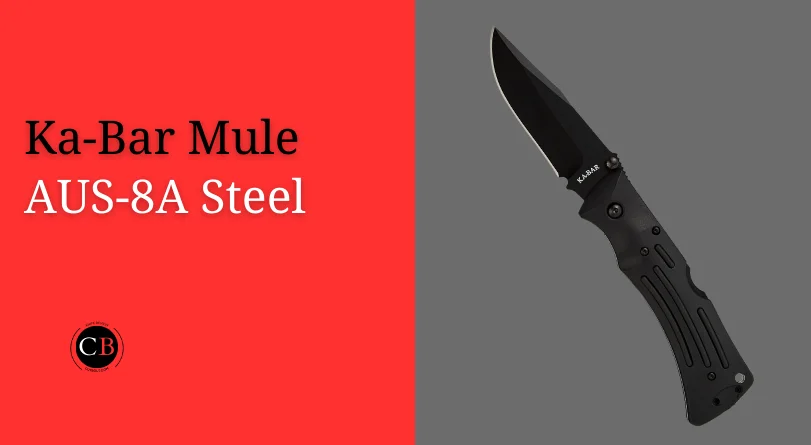
Comparison AUS 8A and 440B/C
| AUS 8 / AUS 8A | 440B | 440C |
| Carbon: 0.7 – 0.75% | Carbon: 0.75 – 0.95% | Carbon: 0.95 – 1.20% |
| Chromium: 13 – 14.50% | Chromium: 16.00 – 18.00% | Chromium: 16 – 18.00% |
| Molybdenum: 0.1 – 0.3% | Molybdenum: 0.75% | Molybdenum: 0.75% max. |
| Vanadium: 0.1 – 0.26% | Manganese: 1.00% | Manganese: 1.00% max. |
| Nickel: 0.49% | Silicon: 1.00 % | Silicon: 1.00% max. |
| Manganese: 0.50% | Phosphorus: 0.40% | Phosphorus: 0.40% max. |
| Silicon: 1.00% | Sulfur: 0.03% | Sulfur: 0.03% |
| Phosphorus: 0.04% | ||
| Sulfur: 0.03% | ||
Strengths and weaknesses of AUS 8A knife steel
AUS-8A, a close cousin to 440 steel, shines in terms of easy sharpening and rust resistance. However, its edge retention falls short compared to high-carbon steels.
While varying opinions exist on the reason for its faster dulling (some blame oxygen content, others find weekly sharpening sufficient), one thing remains clear: the quality of an AUS-8A blade heavily depends on the manufacturer’s crafting and heat treatment techniques.
Remember, even steels with the same name like AUS-8A or 440C can exhibit different properties based on their forging process. This means an AUS-8A blade from one maker might be harder or softer than another, impacting its overall performance.
In essence, while AUS-8A boasts excellent sharpening ease and rust resistance, its edge retention requires consideration. Additionally, the quality of any blade, regardless of steel type, hinges heavily on the manufacturer’s skill and techniques.
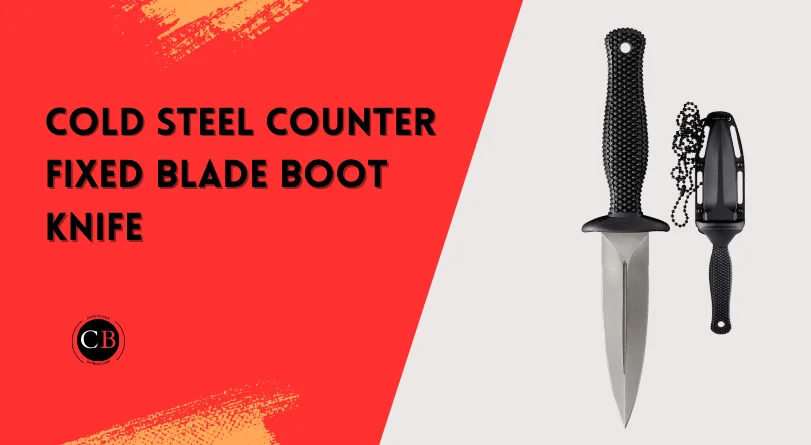
Is AUS 8A a stainless steel?
While AUS-8A boasts excellent rust resistance thanks to its chromium content exceeding 10%, it technically falls short of the official “stainless steel” classification. For a steel to be deemed rust-free, it typically requires a chromium content ranging from 10.5% to 13%, integrated into either the austenite or ferrite. Stainless steel, on the other hand, must maintain sulfur and phosphorus levels below 0.025%, known as iron companions. AUS 8A slightly exceeds phosphorus and sulfur content, at 0.04% and 0.03% respectively, although marginal, exceed these thresholds. Consequently, AUS 8A does not meet the criteria for stainless steel classification.
Is AUS 8A steel good for knives?
AUS 8A makes for a good all-around knife steel, especially given its budget-friendly cost. It hits a nice sweet spot between performance and price that suits it well for a variety of uses.
The 13-14% chromium imparts decent corrosion resistance, allowing the blades to resist wear from moisture or fruit acids without heavy maintenance.
And the 0.75-0.80% carbon content enables impressive sharpness potential coupled with adequate edge retention suitable for most daily cutting tasks. While touching up the edge will be needed after heavy usage periods, AUS 8A takes a keen edge easily enough on basic sharpening gear.
Where the steel does fall slightly short is in achieving the extreme hardness or wear resistance necessary for highly demanding jobs. The hardness range caps out in the vicinity of 59 HRC, which lags elite cutlery grades specialized for ultimate toughness.
So AUS 8A won’t retain razor sharpness as long or resist abrasion or microchipping as certain premium alloys can. But that is an expected tradeoff in order to keep costs reasonable.
For general kitchen duties, camping, or EDC, AUS 8A steel presents an optimal formula combining capable real-world cutting reliability with accessibility most buyers can appreciate.
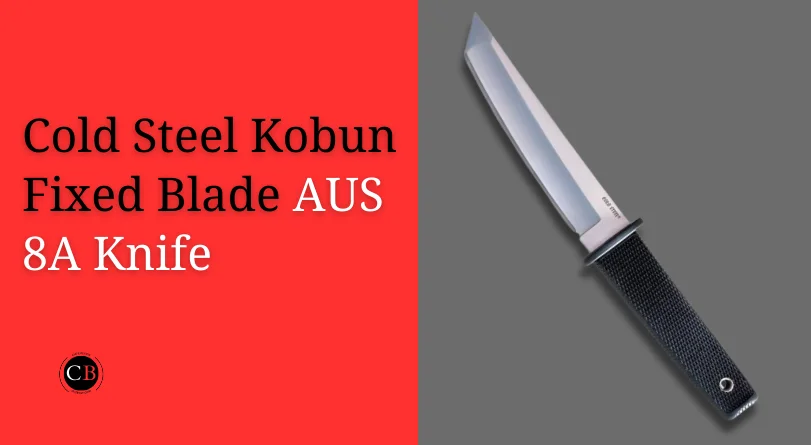
Final Words: AUS 8A steel review
AUS 8A is a great material for quality knives. AUS 8A knife steel may not perform as well as quality tool steel, and you won’t find it at knife manufacturers like Benchmade.
But, you get a lot of knives for the money with this low-carbon, stainless steel. AUS 8/8A is very similar to Crucible 440 B/C and is therefore often used in mass-production knives, including machetes.


